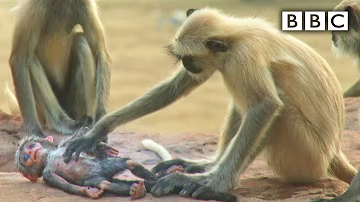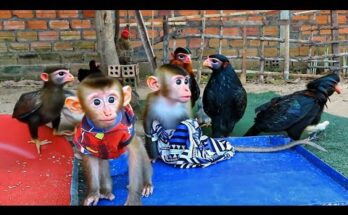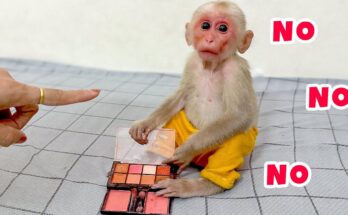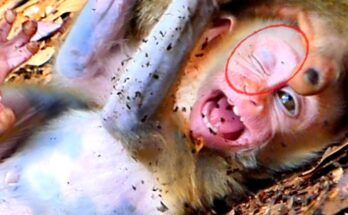
The BBC’s groundbreaking series Spy in the Wild introduced a life-sized robotic baby langur, designed to blend in perfectly with a real monkey troop. This mechanical monkey, equipped with cameras in its eyes, was intended to capture intimate moments of monkey life without disturbing the natural behaviors of the group.
At first, the langurs were curious. They approached the robotic infant gently, sniffing and inspecting it. Its stillness didn’t seem strange at first—perhaps it was just shy, or tired. One of the females, likely a mother herself, carefully picked it up and held it close. Others gathered around, watching with interest and cautious affection.
But then, something unexpected happened.
As the robot baby was accidentally dropped from a tree during handling, it fell lifelessly to the ground. Immediately, the mood of the group shifted. The monkeys rushed down, surrounding the unmoving figure. They reached out hesitantly. No movement. No sound. It didn’t respond.
What followed was a haunting and deeply moving display: the langurs began to grieve.
One by one, they touched the fake baby, cradled it, and looked into its eyes. Some sat silently beside it, as if keeping vigil. Others seemed to comfort one another, embracing gently. A few stared off into the distance, eyes filled with something unmistakable—sorrow.
Despite the baby being artificial, the langurs responded as if it had truly died. Their reaction wasn’t mere confusion—it was mourning. Their body language, their gestures, and their silence echoed the pain of loss seen across species, even in humans.
This extraordinary moment stunned the filmmakers. While many know that animals feel, witnessing wild langurs grieve so profoundly over what they perceived as a fallen infant showed a powerful truth: empathy runs deep in the animal world.
The scene is a testament to the emotional complexity of langurs. They live in close-knit groups, where bonds are strong and care for the young is shared among many members. The sight of a baby—any baby—in distress or stillness triggered their instinctual compassion and communal sorrow.
The fake baby had revealed something very real.
This moment didn’t just inform viewers about primate behavior. It touched hearts, broke barriers between species, and invited the world to rethink how we perceive animal emotions. Grief, it turns out, is not only a human experience. It is a language shared in gestures, silence, and sorrowful eyes—even in the treetops of an Indian forest.


